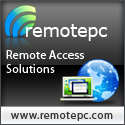The term Remote Desktop Protocol generally describes a built in component of Windows, Linux, Mac, or other operating systems that enable the access and control of a computer from a remote location. Basically, it is an application that allows a person to control their home/work desktop as if they were sitting in front of it. This protocol as well as the service has been available for some time. However, through the years significant improvements have been made with technological advances. In addition, alternative types of remote access connections are now available in various forms.
There are pros and cons to using Remote Desktop Protocol to connect to a computer remotely. The limitations are generally what cause people to search for alternative ways to gain remote access. First of all, Remote Desktop Protocol logs users into a new session each time it is used, and does not typically let them work within the current session. Also, Remote Desktop Protocol usually allows only one or a handful of computers to have remote access during the same time. Alternative programs/connections for remote access provide solutions for some of the limitations of Remote Desktop Protocol. They may also include additional features and benefits such as heightened security and communication tools.
Probably the most well know alternative to Remote Desktop Protocol is VNC. VNC stands for Virtual Network Computing. It is a platform independent desktop sharing system that relays information over a network. The operation for transferring information using VNC differs from that of Remote Desktop Protocol. Therefore, it can allow multiple users to access a computer remotely at the same time and during the current session. However, VNC is often slower than using Remote Desktop Protocol.
A number of variants of VNC are available, each offering their own particular functionality. Real VNC is a popular VNC client for Windows and Linux. It can also be used with other operating systems by running a different VNC server, and is available in several different versions. Tight VNC is an open source VNC server that allows you to operate your computer from any operating system. It provides optimized performance and allows for maximum bandwidth, but has to be in use at both ends in order for the computers to communicate. Ultra VNC is a free version of Windows-Windows remote control that offers some additional features. In addition, there are VNC clients that allow remote desktop access via a mobile device, such as a smart phone.
There are a large number of third party software programs and web based applications that offer an alternative to Remote Desktop Protocol and enable remote desktop access. LogMeIn, GoToMyPC, and TeamViewer are among some of the more popular ones. These programs work to provide remote connections across the web, while providing additional features for mass communication, and a user friendly interface. File sharing, remote printing, diagnostic toolkits, multi monitor support and cell phone access are just a few of the benefits that are often offered by these third party applications.
Java Remote Desktop is another alternative to Remote Desktop Protocol. It is an open source remote connection application that is built on the Java platform. Java Remote Desktop is compatible with most operating systems and has advanced features that include remote sound and clip board transfer.
Windows Live Mesh is another viable option for a remote access. It can run in the browser as well as an application on your PC, and is part of the online services offered by Microsoft Windows Live. This program has some file synchronization features that make it stand apart from other choices, but currently is limited in the operating systems and mobile devices it can be used with.
Choosing an application for remote desktop access can pose a challenge with so many options. There are both free and paid versions of these programs available. Each one tends to vary in capabilities, performance, and security. While some preform general functions, other cater to more specific needs. Selecting a remote access application should be based on the individual needs of the user’s.
 Posted in
Posted in  Tags:
Tags: 